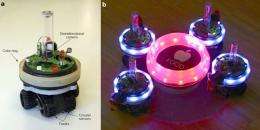September 16, 2009 feature
Robots Reveal Insights into Evolution

(PhysOrg.com) -- In an ironic twist to our understanding of life, robots may offer a greater degree of realism for studying some of the intricacies of natural selection and evolution than real organisms offer. In a recent study, scientists have used evolutionary robots to investigate the evolution of social information. Their results mirror theoretical predictions more closely than results from experiments with real organisms, and may provide an explanation for some of the observed variation in animal species.
“Evolving robots can result in important insights for evolutionary biology, in particular for understanding the evolution of communication,” Sara Mitri of the Ecole Polytechnique Fédérale de Lausanne in Switzerland told PhysOrg.com.
In their study, Mitri and coauthors Dario Floreano, also of the Ecole Polytechnique Fédérale de Lausanne, and Laurent Keller of the University of Lausanne, will publish their results in an upcoming issue of the Proceedings of the National Academy of Sciences. The researchers experimented with computer simulations of populations of 1,000 robots that mimic the dynamic properties of real robots.
In the game-like scenario, the robots competed with each other to find a food source that emitted red light and avoid a poison. Robots received one point for every unit of time spent in the vicinity of food, and lost a point per unit of time spent near poison. Once a robot had located the food, it could stay near the food for the remainder of the game to accumulate as many points as possible. The robots also had the ability to emit blue light, and could sense light emitted by other robots.
As the researchers explained, each robot had 33 genes that were initially set to random values, so that the behavior of the robots was random in the first generation. The genes controlled characteristics such as how the robots processed sensory information and produced motor actions, such as emitting flashes of light.
Once robots evolved the ability to find food and stay nearby, their increased density near the food source also caused an increased density of flashing blue lights near the food, providing a source of information for other robots. After about nine generations, the robots became significantly attracted to blue light, resulting in even more robots crowding around the food. In response to this crowding, the robots began to be selected to decrease their own rate of blue light emission.
However, blue light emission never completely decreased to zero, even after 500 generations of evolving robots. As the researchers explained, this somewhat surprising result can be explained by the reduced selection pressure on light emission reduction. As light emission decreased, it became less informative to other robots, and less of a liability to the robots emitting the light.
“Evolutionary processes do not necessarily lead to ‘optimal’ solutions (in this case, a complete suppression of information) but consist of a complex interplay of selection pressure and variation,” Mitri said.
One important consequence of the reduced selection pressure on light emission is that, at equilibrium, there was a large amount of variation in both the production of and response to light among the robots. While most robots exhibited only a low attraction to blue light and rarely or never emitted light near food, a significant number of robots was still highly attracted (or even negatively attracted) to light, and some still emitted a lot of light near the food. The researchers speculate that complete suppression of light might never be achieved, since a reduction in this information will simultaneously reduce selection pressure on information reduction.
In general, this result means that, as selection pressure decreases on a trait, phenotypic diversity of that trait increases. This finding agrees with previous studies that have found higher than expected variation in populations’ signaling strategies; for instance, the great degree of coloration in moths has so far eluded explanation. Perhaps, as the robot experiments suggest, these moth populations have experienced a decrease in selection pressure on their coloring.
As the researchers conclude, evolutionary robotic systems like the one here may provide insight into understanding evolution and natural selection due to their implicit, inadvertent behaviors, such as emitting and sensing light while foraging. The experimental results here are also more in line with theoretical predictions than other empirical studies, supporting the view that more controlled experiments are needed in studies with real organisms.
“Because we can watch how robots evolve over many generations, we can formulate hypotheses and predictions regarding evolutionary systems in nature,” Mitri said. “These predictions can then be used to inspire biologists working with the real animals by providing them with potential explanations for what they observe. We do not claim that our robots are the same as any animals, but we suggest what biologists may want to test next to answer their questions.”
More information: Sara Mitri, Dario Floreano, and Laurent Keller. “The evolution of information suppression in communicating robots with conflicting interests.” Proceedings of the National Academy of Sciences. To be published.
Copyright 2009 PhysOrg.com.
All rights reserved. This material may not be published, broadcast, rewritten or redistributed in whole or part without the express written permission of PhysOrg.com.















